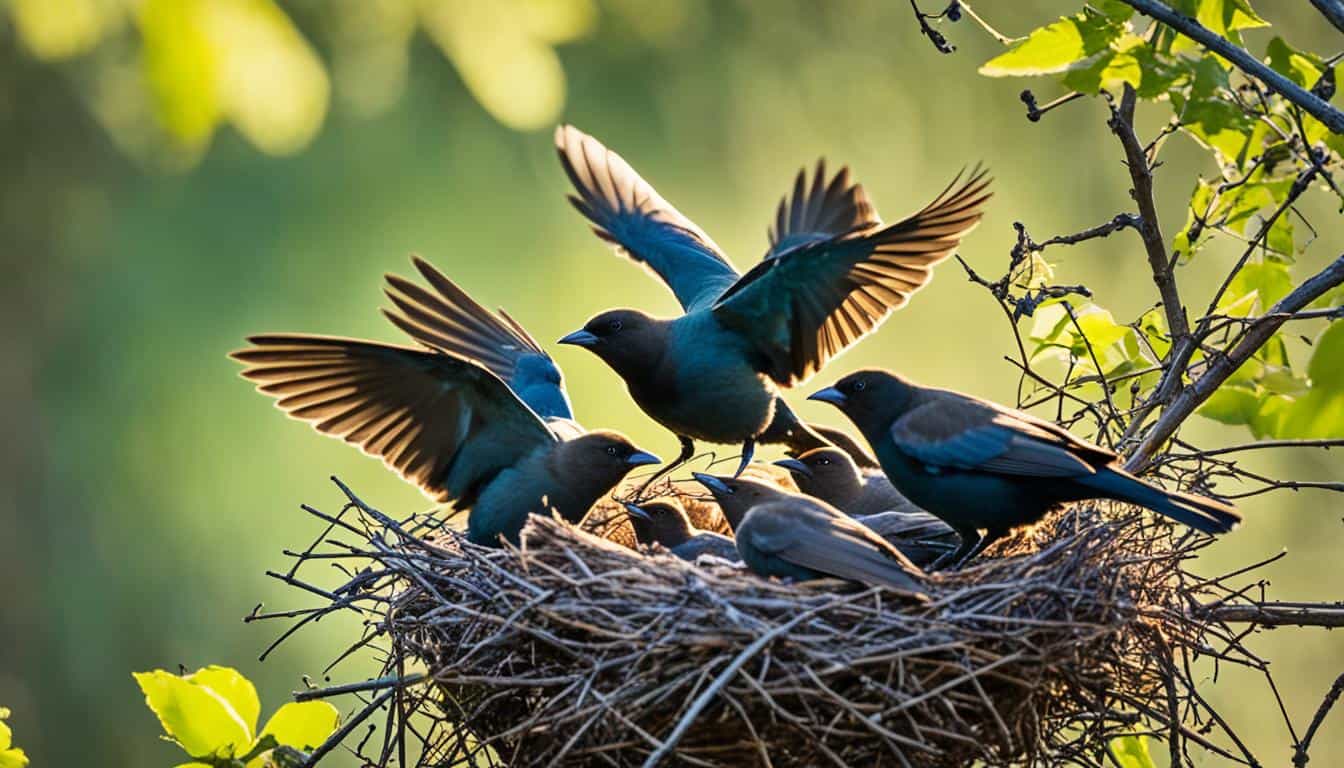Brown-headed Cowbird: North America’s Brood Parasite
The Brown-headed Cowbird (Molothrus ater) is fascinating. It parasitizes over 220 North American bird species. It lays eggs in other birds’ nests. These birds then raise the cowbird’s chicks, unaware they’re not their own.
This bird is North America’s top brood parasite. Female cowbirds lay many eggs per season. This harms the populations of many songbirds. It affects the host birds and their own chicks.
In this article, we’ll dive into the world of the Brown-headed Cowbird. We’ll look at its breeding behavior, the many bird species it uses as hosts, and ways some birds protect against its parasitic actions.
Introduction to the Brown-headed Cowbird
The Brown-headed Cowbird is a unique bird in North America. It does not build its own nest. Instead, the female cowbird lays her eggs in the nests of other bird species. This means the host bird parents end up caring for the young cowbirds.
A single female cowbird can lay more than 36 eggs in one summer. This shows its impressive egg laying ability.
The Basics of Brown-headed Cowbirds
Female cowbirds do not build their nests. Instead, they lay eggs in the nests of other birds. This is known as parasitic behavior. The young cowbirds often grow quicker and larger than the host’s own babies. This helps them get more food and care, sometimes at the expense of the real baby birds.
Some bird species can tell when a cowbird egg is in their nest. They might remove it or cover it. But many can’t tell the difference between their own eggs and that of the cowbird. This is how the cowbird can sometimes fool the other birds into raising their young.

Researchers are still trying to figure out if baby cowbirds find their real parents later. It’s a tough question due to the cowbird’s complicated breeding habits. It’s hard to say how much the young cowbirds interact with their birth parents.
The way the Brown-headed Cowbird breeds is very interesting to scientists and those who love birds. Studying this bird helps us learn more about how nature works. It shows us the special ways different birds act because of their environment and history.
Habitat and Range of the Brown-headed Cowbird
The brown-headed cowbirds are native to the central United States and Canada. They lived in the open grasslands with bison. When humans cleared forests and made more fields, these birds spread. They now live over most of North America.
You can see brown-headed cowbirds in fields, meadows, and even suburbs. They join other blackbirds for food and shelter in winter.
These birds are good at using environments changed by people. They live in many places from the countryside to city gardens. This makes them easy to spot for those who love nature and birds.
“The brown-headed cowbird is a remarkable example of a species that has been able to capitalize on the changes brought about by human activity, expanding its range and population to become a ubiquitous presence across much of North America.”
Expanding Range and Adaptability
The brown-headed cowbird’s success comes from its ability to adapt. With landscape changes made by people, they found new places to live and eat. This helped them grow in number and spread to different environments.
- Historically, brown-headed cowbirds followed bison herds across the open grasslands of the central United States and Canada.
- As forests were cleared and agricultural areas expanded, cowbirds found ample new feeding and breeding grounds, leading to a rapid expansion of their range.
- Today, brown-headed cowbirds can be found in fields, meadows, and even suburban lawns, often flocking with other blackbird species during the winter and migration seasons.
The ability of the brown-headed cowbird to fit in many habitats is a big part of their success. They are now everywhere in North America because of this.
Breeding Behavior and Host Diversity
The brown-headed cowbird has a unique way of breeding. These birds lay many eggs in other birds’ nests during the breeding season. They look for nests of different bird species to leave their eggs.
If the cowbird finds a good nest, it may take out the host’s eggs. This helps their chicks get more food and attention from the host parents.
Egg-laying and Parasitism
Female brown-headed cowbirds can lay up to 40 eggs a season. This is quite impressive. They find nests of other birds to lay their eggs in.
When they see a good nest, they might remove some of the host’s eggs. This way, their egg gets a head start, getting more care and food.
Some host birds can tell and get rid of cowbird eggs. But, many hosts can’t stop the cowbirds. So, the cowbirds often win, getting more from the host parents. Even though some birds outwit them, cowbirds still find ways to have babies across North America.
| Host Species | Parasitism Rate | Rejection Rate |
|---|---|---|
| Song Sparrow | 50% | 30% |
| Yellow Warbler | 75% | 45% |
| Red-winged Blackbird | 60% | 20% |
“The brown-headed cowbird’s reproductive strategy is a fascinating example of the evolutionary arms race between brood parasites and their hosts.”
Brown-headed Cowbird
The brown-headed cowbird is special because it doesn’t make its own nest. Instead, it uses other bird’s nests to lay its eggs. These other birds then feed and care for the cowbird babies. This can hurt the other bird populations. Especially those already struggling to survive.
Female cowbirds don’t bother with nesting or taking care of their eggs. They just find a nice nest, drop their egg, and go. They usually pick nests of smaller birds. This way, the smaller bird families end up supporting the cowbirds instead of their own chicks.
This approach helps cowbirds have more babies. Plus, they don’t have to worry about building or protecting nests. But it harms the host birds. The cowbird chicks grow faster and bigger. This leads to them getting more attention and food, leaving little for the host bird babies.
“The brown-headed cowbird is a remarkable bird, both in its reproductive strategy and its impact on the avian community.”
Some bird species have found ways to protect themselves from the cowbirds. But most can’t tell the difference in the eggs. This lack of knowledge affects their ability to reproduce and can reduce their numbers over time. Many scientists and bird lovers find this battle between host species and the cowbirds very interesting.

To help protect songbirds, it’s important to understand the cowbird issue. Making people aware and finding ways to manage this problem can help protect our songbird friends. We can keep these unique species from disappearing in the wild.
Host Defenses and Impacts
The Brown-headed Cowbird is a challenge for many songbird species. Some birds, like the Yellow Warbler, have learned to spot cowbird eggs. They reject them or even build a new nest on them. This skill shows how flexible and strong these birds are against the cowbird’s tricks.
Recognizing and Rejecting Cowbird Eggs
But, not all birds are lucky like the Yellow Warbler. Some can’t tell the cowbird eggs from their own. These birds then care for the cowbird chicks, which can harm their own young ones. Since cowbirds grow faster, they often take over the nest, making it hard for the host species to succeed.
This situation can lead to some endangered birds becoming even rarer. It shows the serious problem caused by the cowbird. While sometimes the host bird wins, the question if baby cowbirds reunite with their parents is still being studied.
“The cowbird’s ability to lay eggs rapidly and its nestlings’ faster growth rate give them a significant advantage over the host’s young, leading to reduced nesting success for the host species.”
| Host Species | Ability to Recognize and Reject Cowbird Eggs | Impact on Nesting Success |
|---|---|---|
| Yellow Warbler | High | Low |
| Eastern Phoebe | Moderate | Moderate |
| House Finch | Low | High |
Also Read Our Previous Articles
| Mourning Dove Facts |
| Hawks in Florida |
| Hawks In Iowa |
| House Finch vs Purple Finch: Spot the Difference |
| Swallow Spiritual meaning: Symbolism & Significance |
Final Thoughts:
The Brown-headed Cowbird stands out as a rare bird species. It’s famous for its trickery with other bird species in North America. This bird relies on laying eggs in other bird’s nests to raise its young, leaving the host birds to care for them.
Many hosts can’t tell which eggs are theirs and which are not. This leads to trouble for them as they raise the wrong kind of chicks. Although some bird species have learned to fight back, most are at a disadvantage.
Understanding this game of survival is key to helping vulnerable songbirds. By studying these birds, we learn a lot about the challenges in nature. This knowledge can guide us in protecting North America’s bird diversity for the future.






